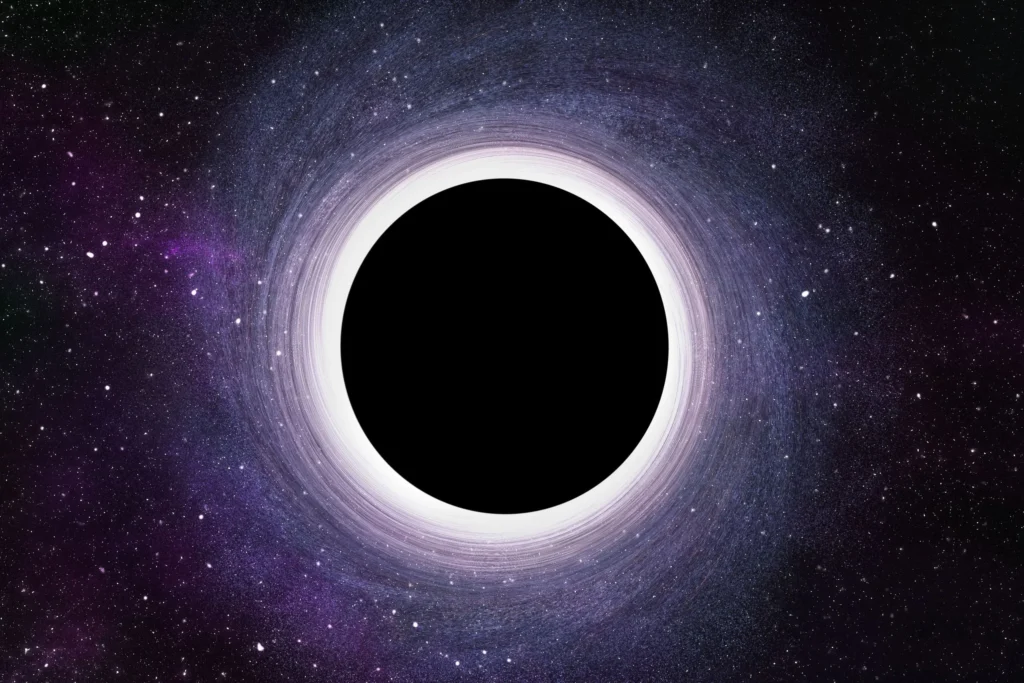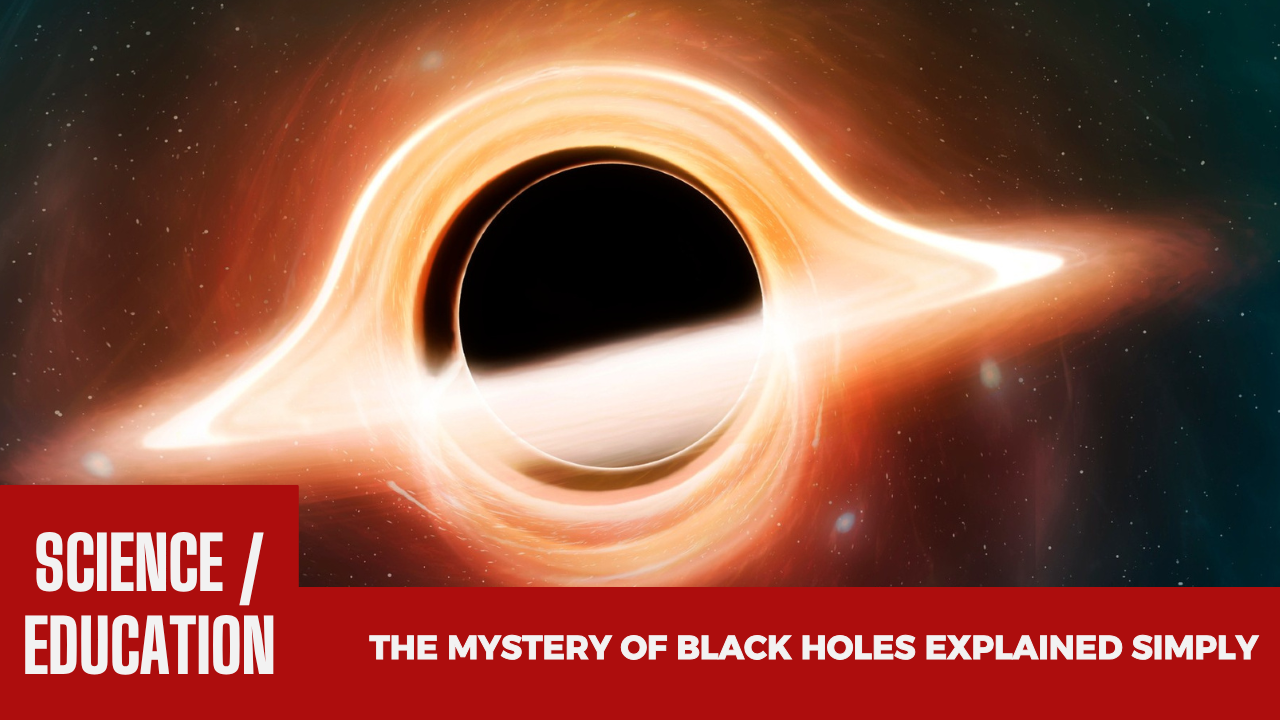The phrase black hole sounds dramatic, almost frightening — like something ripped from the pages of a science-fiction novel. Yet, black holes are not inventions of imagination; they’re very real, hiding silently in the fabric of space. To astronomers, they represent both fear and fascination, a puzzle that pushes the limits of human knowledge. For ordinary people, they’re symbols of the unknown. But what exactly are these cosmic giants? And why do they continue to draw the world’s brightest minds into their gravitational pull?
By Rahul | Science / Education | September 10, 2025
What is a Black Hole?

At its core, a black hole is a place where gravity rules supreme. Gravity is so powerful here that nothing — not even light, the fastest traveler in the universe — can escape. This is why black holes are “black.”
They form when a massive star burns through its nuclear fuel and collapses under its own weight. Imagine compressing something as large as our Sun into a tiny point smaller than a city — that’s the scale of collapse we’re talking about. This point is called a singularity, a region where all known laws of physics break down. Surrounding it is the event horizon, the invisible boundary beyond which there is no return.
Why Are Black Holes Invisible?
Here’s the strange part: we cannot directly see black holes. Because they swallow light, they’re essentially invisible. But scientists aren’t blind to their presence. They study the effect black holes have on their surroundings.
Gas clouds heat up and glow brightly as they spiral into a black hole. Stars that wander too close may be ripped apart. Even entire systems of stars reveal the presence of something massive pulling on them. In 2019, the world got its first-ever photograph of a black hole, captured by the Event Horizon Telescope. It looked like a glowing orange ring with a dark shadow in the middle — the closest humanity has come to seeing the unseeable.
Black holes form when really massive stars die. Looking directly at them, it looks like… nothing. But we still can observe black holes because of their effect on matter. Many of these powerful things have discs of matter orbiting outside the event horizon. pic.twitter.com/BqMLhn7Hal
— Kurzgesagt (@Kurz_Gesagt) February 18, 2023
Types of Black Holes
Not all black holes are the same. Astronomers generally divide them into three categories:
- Stellar-mass black holes: Created when giant stars collapse. They are a few times heavier than our Sun.
- Intermediate black holes: Rarer and less understood, possibly formed when smaller black holes merge.
- Supermassive black holes: Monsters sitting at the center of galaxies, weighing millions or even billions of suns. Our own Milky Way galaxy has one called Sagittarius A*, quietly holding everything together.
Why Do Black Holes Matter?
Black holes may sound like destructive beasts, but they’re also cosmic architects. They shape galaxies, bend time, and warp space. For physicists, they’re natural laboratories where Einstein’s theory of relativity is put to the ultimate test. For astronomers, they help explain how galaxies form and evolve.
Even more fascinating is how black holes affect time. According to Einstein, the closer you get to a black hole, the slower time moves compared to the outside world. In theory, an astronaut near the event horizon could experience just a few hours while years pass elsewhere. Science fiction? Not quite. It’s physics.
The Human Fascination
Why do we, sitting on a small blue planet, care so much about something so far away? Maybe it’s because black holes remind us of mystery itself. They represent the limits of our understanding — places where equations fail and imagination begins. For school students, they’re often the “gateway drug” into astrophysics. For scientists, they’re a never-ending challenge.
Final Thought
In the end, black holes are not just scientific curiosities; they’re reminders of how vast and humbling the universe really is. They teach us that no matter how much we know, there will always be questions that pull us deeper. Perhaps that’s why black holes continue to fascinate us: because every great mystery is also an invitation to discover.
FAQs
Q1: How big is a black hole?
Some are only a few kilometers wide, while supermassive ones can stretch across millions of kilometers.
Q2: Can a black hole destroy Earth?
No. There are no black holes near enough to pose any danger to our planet.
Q3: What happens if you fall into a black hole?
In theory, you’d be stretched into a thin strand of matter — a process called “spaghettification.”
Q4: How do scientists study black holes if they’re invisible?
They observe the motion of nearby stars and gases, as well as radiation emitted when matter falls into black holes.
Q5: Why are black holes important in physics?
They help test theories of gravity, time, and space at extremes that cannot be recreated in labs.
Read more interesting blogs related to science and education
- CRISPR and the Future of Medicine – How Gene Editing is Changing Healthcare
- How AI is Changing the Future of Education in 2025
Newstic Author Bio – Rahul
Rahul explores technology by asking what it means for people first. From AI in classrooms to the latest gadgets on the shelves, he explains how innovation is reshaping everyday life in India — in offices, schools, and even in homes.learn more
Disclaimer
This article has been prepared and published by Newstic.in for informational and news reporting purposes only. While every effort has been made to ensure accuracy and reliability, readers are advised that details such as prices, specifications, dates, or other event-related information may change over time. Newstic.in does not take responsibility for any business or personal decisions made based on this content. For the latest updates, always refer to official announcements, verified sources, or consult with relevant professionals. Opinions expressed by analysts, buyers, or third parties quoted in this article are their own and do not necessarily reflect the views of Newstic.in.















